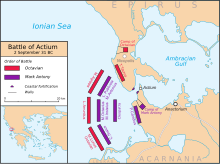|
31 BC
 Year 31 BC was either a common year starting on Tuesday, Wednesday or Thursday or a leap year starting on Tuesday or Wednesday (link will display the full calendar) of the Julian calendar (the sources differ, see leap year error for further information) and a common year starting on Tuesday of the Proleptic Julian calendar. At the time, it was known as the Year of the Consulship of Antonius and Caesar or as Caesar and Messalla (or, less frequently, year 723 Ab urbe condita). The denomination 31 BC for this year has been used since the early medieval period, when the Anno Domini calendar era became the prevalent method in Europe for naming years. EventsBy placeRoman Republic
Roman Palestine
By topicArt
Births
Deaths
ReferencesWikimedia Commons has media related to 31 BC.
|